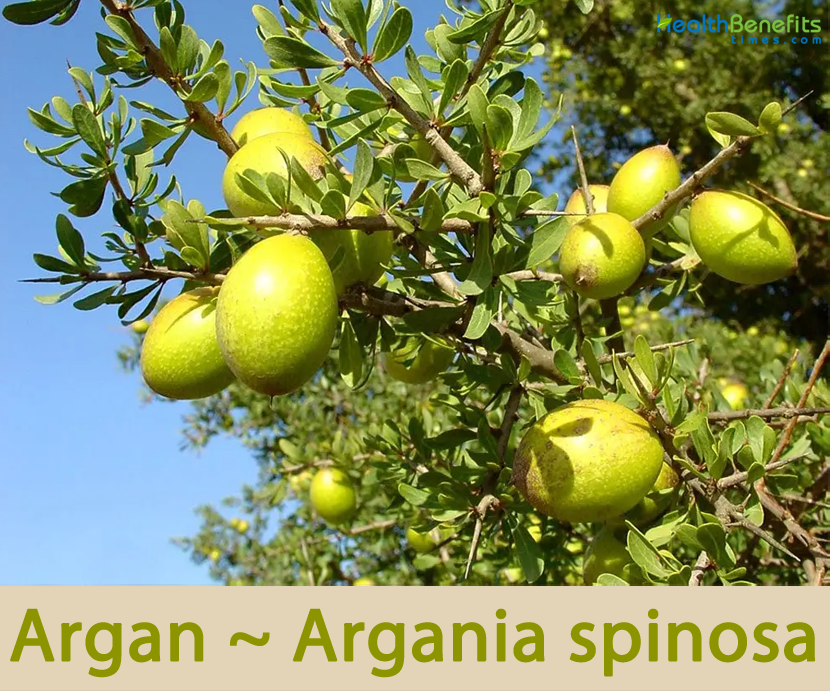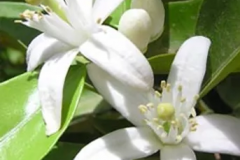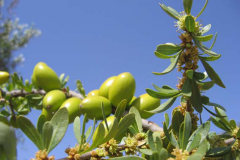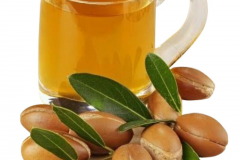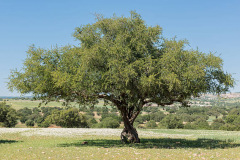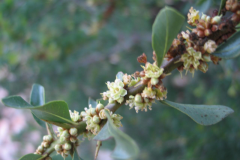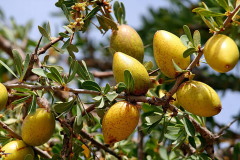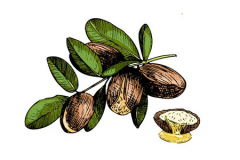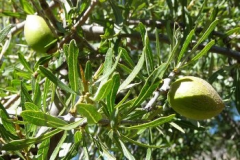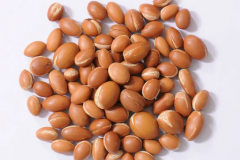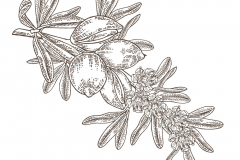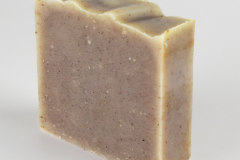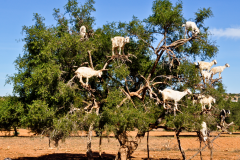Genus name comes from the Latinized version of the local Moroccan name. Specific epithet comes from the Latin word spinosus meaning spiny. The tree is a very important local source of high quality edible oil. The tree is occasionally cultivated as an oil crop and this cultivation is spreading to areas outside its native range. The oil pressed from the seeds has been used in Morocco since ancient times as cooking oil in somewhat the same way as olive oil is used. Oil is rich in vitamin E. This tree was relatively unknown in North America until the end of the 20th century when the oil skyrocketed in popularity and price because of newly-discovered benefits from its use as an ingredient in human cosmetic products. The tree is known to live up to 200 years, and is an essential part of its environment in providing for people and animals as well as preventing erosion and desertification. The oil extracted from the seeds of this tree has played and is still playing an ever-increasing role in the culinary, cosmetic and medicinal applications, not only traditionally in the local Berber society but also on a global level.
Argan Tree Facts
| Argan Quick Facts | |
|---|---|
| Name: | Argan |
| Scientific Name: | Argania spinosa |
| Origin | Calcareous semi-desert Sous valley of southwestern Morocco |
| Colors | Green to bright yellow in color |
| Shapes | Round to oval, ovoid fleshy drupes 2–4 cm (0.79–1.57 in) long and 1.5–3 cm (0.59–1.18 in) broad |
| Health benefits | Support blood cholesterol levels, blood circulation, digestion, chicken pox pustules, juvenile acne, stretch marks and relieves sore muscle and joints |
| Name | Argan |
|---|---|
| Scientific Name | Argania spinosa |
| Native | Calcareous semi-desert Sous valley of southwestern Morocco |
| Common Names | Argan Tree, Spiny Argania, Morocco Ironwood, argan, Goat-tree, Argan almond, Argan fruit, Argan oil, Argan tree, Moroccan fodder tree, Moroccan iron-wood tree, ironwood |
| Name in Other Languages | Afrikaans: Argan Albanian: Argan Amharic: Arigani (አርጋን) Arabic: Arghan (أرغان), Ardjan, al’arkan (الأركان), Argân, Arqân (اﺭ قان), Arkaan (ﺃﺭﻛﺎﻥ), earajn (عرجن), Al arkaan (الأركان), Lawz el barbar Armenian: Argan (արգան) Azerbaijani: Arqan Bengali: Argan Bulgarian: Arganovo (арганово) Burmese: Aar gaan (အာဂန်) Chinese: Móluògē jiānguǒ (摩洛哥坚果) Croatian: Arganovo Czech: Argan Danish: Argan, Argantræ Dutch: Argan, Arganboom, Arganolie, Marokkaanse olijfboom, arganie English: Argan, Argantree, Goat-tree, Argan almond, Argan fruit, Argan oil, Argan tree, Moroccan fodder tree, Moroccan iron-wood tree, ironwood Esperanto: Argan Estonian: Argaan Filipino: Argan Finnish: Argan French: Argan, Aranier, Bois de fer, Arbre fourrager du Maroc, Bois de fer du Maroc, Huile d’argan, Huile d’arganier, Olivier du Maroc, bois d’Argan Georgian: Argani (არგანი) German: Argan, Arganbaum, Arganie, Arganöl, Eisenbaum, Eisenholz, afrikanischer Arganbaum, marokkanischer Eisenholzbaum, Schlangenhautbaum Greek: Árnkan (Άργκαν) Gujarati: Argan Hausa: Argan Hebrew: ארגן Hindi: Argan Hungarian: Argan Icelandic: Argan Indonesian: Argan Irish: Argan Italian: Argan, Albero legno ferro, Argania, Arganio, Olio di Argania, legno ferro del Marocco Japanese: Arugan (アルガン), Arugania (アルガニア), Arugan oiru (アルガンオイル) Javanese: Argan Kannada: Argān (ಅರ್ಗಾನ್) Kazakh: Arhan (арган) Korean: Aleugan (아르간) Kurdish: Argan Lao: Argan Latin: Argan Latvian: Argans Lithuanian: Arganas Macedonian: Argan (арган) Malagasy: Argan Malay: Argan Malayalam: Argan (അർഗൻ) Maltese: Argan Marathi: Argan Mongolian: Argan (арган) Morocco: Ardjan Nepali: Argan Norwegian: Argan Oriya: Argan Pashto: ارګ Persian: آرگان Polish: Argan Portuguese: Argan, argânia Punjabi: Āragana (ਆਰਗਨ) Romanian: Argan Russian: Arganovoe (аргановое), Argan (Арган), Arganniia koliuchaia (Аргания колючая), arganiya (аргания) Serbian: Argan (Арган) Sindhi: آرگن Sinhala: Agan (ආගන්) Slovenian: Argan Spanish: Argán, Aceite del argán, argània Sudanese: Argan Swedish: Argan, Arganträd Tajik: Argan (арган) Tamil: Ārkaṉ (ஆர்கன்) Telugu: Argan Thai: Argan Turkish: Argan, Argan ağacı , Marok zeytin ağacı Ukrainian: Argan (арган) Urdu: آرگن Uzbek: Argan Vietnamese: Argan Welsh: Argan Zulu: I-argan |
| Plant Growth Habit | Long-lived, evergreen, thorny, medium-sized shrub or small tree |
| Growing Climates | Slopes of rough hills, seeming to thrive between the rocks on poor soil |
| Soil | Thrives in almost all kinds of soils, with a preference for sandy deposits and poor desert soils |
| Plant Size | 8-10 m tall, sometimes up to 20 m with a trunk diameter of up to 100 cm |
| Root | Strong root system can reach a depth of 35 m, making it able to survive droughts, and suitable for arid and semi-arid areas |
| Leaf | Leaves are small, clustered and lanceolate up to 2–4 cm (0.79–1.57 in) long, and oval with a rounded apex.They can absorb any moisture from the air |
| Flowering season | May-June |
| Flower | Inflorescences are axillary borne. The flowers are small, bisexual with five greenish-yellow colored petals. |
| Fruit Shape & Size | Round to oval, ovoid fleshy drupes 2–4 cm (0.79–1.57 in) long and 1.5–3 cm (0.59–1.18 in) broad |
| Fruit Color | Green to bright yellow in color |
| Fruit Skin | Thick, bitter peel |
| Seed | One (occasionally two or three) small, oil-rich seeds |
| Propagation | By Seed |
| Plant Parts Used | Seed oil |
| Lifespan | Approximately 200 years |
| Season | June to July |
| Precautions |
|
Plant Description
Argan tree is a long-lived, evergreen, thorny, medium-sized shrub or small tree that normally grows about 8-10 m tall but exceptionally reaching 21 meters. The bole can be 100 cm in diameter. Its life span is said to be anywhere from 125 to 450 years and the tree may not come into full production until it is 40-60 years old. The knotty trunk can sometimes have several criss-crossed stems and wide spreading crown. The crown has a circumference of about 70 m (230 ft.) and the branches lean towards the ground. The plant has strong root system that can reach a depth of 35 m, making it able to survive droughts, and suitable for arid and semi-arid areas. The plant is found growing in slopes of rough hills, seeming to thrive between the rocks on poor soil. The plant can thrives in almost all kinds of soils, with a preference for sandy deposits and poor desert soils.
Leaves
The leaves are small, clustered and lanceolate up to 2–4 cm (0.79–1.57 in) long, and oval with a rounded apex. They can absorb any moisture from the air
Flower
The inflorescences are axillary borne. The flowers are small, bisexual with five greenish-yellow colored petals. Flowering normally takes place in between May-June.
Fruits
Fertile flowers are followed by round to oval, ovoid fleshy drupes 2–4 cm (0.79–1.57 in) long and 1.5–3 cm (0.59–1.18 in) broad, with a thick, bitter peel surrounding a sweet-smelling but unpleasantly flavored layer of pulpy pericarp. They are green to bright yellow in color and their pulp consists of milky latex unpleasant for humans. They are quite similar to olive fruits, but larger and rounder, and they may contain up to 3 small oil rich seeds. The argan seed is a hard-shelled nut containing 1-3 kernels and yielding 50% of edible oil. The fruit takes over a year to mature, ripening in June to July of the following year.
In the past, fruits are beaten off the branches and were fed to goats then the nut recovered from the animal dung. Today, in many cases, the fruit is gathered and the nut extracted by machines. From hundreds of kilograms of fruits, only 5 kilograms of nuts and only one liter of argan oil are obtained.
Traditional uses and benefits of Argan Tree
- Argan seed oil is rich in vitamin E and can lower blood cholesterol levels, stimulate blood circulation, facilitate digestion, and strengthen the body’s natural defenses.
- The oil is also edible and can be mixed with almonds and honey, or wheat germ and honey.
- It is used as a cure for chicken pox, to treat juvenile acne and help remove stretch marks on pregnant woman.
- Argan oil is traditionally used to treat belly stretch marks, chicken pox pustules and acne.
- The presence of Triterpenoids fades away the signs of early aging like fine lines, age spots, and wrinkles.
- It rejuvenates the cells by penetrating deep into the skin cells. Thus, helps to fade away the scars, burn marks, and stretch marks.
- It balances the moisture levels of the skin and helps prevent the formation of acne.
- It also protects against harmful UV radiation coming from the sun by forming a protective layer on the skin.
- It keeps a good care of the heart by reducing cholesterol levels and prevents blood clots.
- The Antioxidants and Triterpenoids neutralize the free radicals and inhibit the growth of Tumors.
- It increases the levels of Pepsin which stimulates the gastric juices in the stomach. Thus, helps in better digestion.
- Vitamin E treats split ends, dry scalp, and frizzy hair. It restores its lost luster.
- The antibacterial property protects the nail beds from infections. It improves the nail health.
- Besides, it also heals chapped lips and heels.
- It keeps a good care of the liver.
- Massage with this oil is beneficial in relieving sore muscle and joints. It relieves the pain and swelling associated with arthritis.
Ayurvedic Health Benefits of Argan tree
- Acne: Apply it over the affected area at night daily until it cures completely. Note: You may add 4 to 5 drops of Tea Tree Oil in 10 ml of Argan Oil, to make it more effective.
- Wrinkles: Take 2 to 3 drops of Argan Oil in your palms. Spread it over the affected area before going to bed daily.
- Acne Scars: Take 2 to 3 drops of Argan Oil. Apply on the face. Massage for 5 to 10 minutes gently in circular motion. Repeat 2 times a day for a week to fade away the scars due to Acne.
- Cracked Heels: Take 3 to 4 drops of Argan Oil. Gently massage to your Heels and feet for 10 minutes. Wear a pair of socks. Leave overnight. Continue this every night for a week.
- Stretch Marks: Take 3 to 4 drops of lukewarm Argan Oil. Apply it onto the affected area. Massage gently for 10 to 15 minutes. Do this twice a day for a month.
- Excoriation: Apply 3 to 4 drops of lukewarm Argan Oil on the affected area. Gently massage for 10 to 15 minutes. Repeat 3 to 4 time’s day. Do this for a month to get rid of Excoriation.
- Dark Circles around Eyes: Take 1 to 2 drops of Argan Oil. Apply it under the Eyes. Gently massage in the circular motion for 5 to 10 minutes. Do this daily to diminish Dark Circles.
- Frizzy Hair: Apply sufficient amount of Argan Oil to your Hair. Massage gently for 15 to 20 minutes. Wrap your Hair with a towel. Leave it for half an hour. Wash off with shampoo. Repeat this 2 to 3 times a week to keep hair soft and shiny.
- High Cholesterol: Add few drops of Argan Oil in the salads. Daily intake of 10 to 12 g helps to lower down the High Cholesterol.
- Brittle Nails: Take equal amount of Lemon Juice and Argan Oil in a bowl. Dip affected nails for 10 minutes, and then wash them off. Do it twice a day. OR: Take 1 tablespoon of Lemon Juice and add to warm glass of water. Dip your nails for 10 min. It will make your nails white.
- Wrinkles: Take one ounce of Argan Oil and 30 drops each of Geranium Essential Oil and Jasmine Essential Oil. Mix them well. Dab a cotton ball in this blend and apply to the face and neck area. Repeat the process daily before going to bed.
- Frizzy Hair: Take half ounce of water and add 10 drops of Argan Oil and 20 drops of Sandalwood Essential Oil in it. Mix them well. Spray this blend to the scalp and allow it to dry. Repeat the process two times a day. It stimulates hair follicles to release more natural oil that gives hair its shine.
Different Uses
Food: It is an importance as a source of edible (cooking) oil, which is an excellent source of vitamin E. The white seeds consist of up to 50% of light brown oil with oil production being between 1000 to 2000 tons per year. This oil has a high nutritional value in the human diet. The locals mix oil with almonds and honey to make an almond butter; it also mixed with wheat germ and honey to make gruel. The residue from the kernels after oil extraction is a thick chocolate-colored paste called ‘amlou’ which is sweetened and served as a dip for bread at breakfast time in Berber households. Its flavor is similar to that of peanut butter.
Fodder: It is a major source of forage for sheep, goats and cattle. When goats eat the fruit, the fleshy part is digested but the nut, because of its hard shell, is excreted. Later, the nuts are collected by farmers to produce oil. The sun-dried cake residue is also fed to livestock although this reduces the milk quality.
Fuel: The hard, heavy and durable wood gives good charcoal and firewood. The nut-shells are also burned for cooking.
Timber: The wood of the argan, amazingly indestructible by insects, has been used for centuries in carpentry, charcoal, construction and utensils at local level.
Apiculture: Bees often nest in these trees, providing a treasured source of honey.
Lipids: Oil is the most valuable product derived from the tree. In the Essaouira region alone, oil production is between 1000 to 2000 tons per year. The ratio of total unsaturated to total saturated fatty acids is around 4:5. Argan oil consists of about 80% polyunsaturated fatty acids of which 30% is linoleic acid. The specific composition of the oil produced makes it a resource for nutritional, cosmetic and medical usage
Services
Erosion control: Argania spinosa shields thin soils from erosion especially in overgrazed lands. Its roots facilitate water infiltration and replenish ground water hence stabilization of environmental conditions. Roots of the argan tree grow deep in search of water, helping to bind the soil and prevent erosion.
Shade or shelter: It provides valuable shade for humans and livestock as well as the shade protects pasture grasses from the extreme evapotranspiration that would result from direct exposure to sunlight. Pasture grasses grow in the tree’s shade, away from the extreme conditions in direct sunlight.
Reclamation: The argan tree has a fundamental role in the ecological balance. It maintains soils with its roots, insures their fertility and protects them from the erosion which threatens a vast part of the land. Moreover, it facilitates water infiltration and aquifer replenishment. Argan woodlands form a green belt or functions as a buffer against desert advancement in southern Morocco.
Boundary or barrier or support: Argan brushwood is used for fencing and windbreaks.
Intercropping: It can be intercropped with other species hence an agroforestry species.
Culinary Uses
- Edible oil is obtained from the seed.
- Oil is an excellent source of vitamin E, and has a high nutritional value in the human diet.
- The locals mix oil with almonds and honey to make an almond butter. It also mixed with wheat germ and honey to make gruel.
- Residue from the kernels, after oil extraction, is a thick chocolate-colored paste called ‘amlou’ which is sweetened and served as a dip for bread at breakfast time in Berber households.
- Its flavor is similar to that of peanut butter.
- Fruit are pressed for the oil which has an aroma and is used in cooking.
- The oil is used like olive oil for cooking, frying and salad dressing.
Other Facts
- Argan tree can be planted to prevent soil erosion due to its extensive root system.
- It also serves as wind breakers and is used for fencing.
- Its wood is very hard, heavy, and durable thus it is used in carpentry.
- The wood is a good fuel and makes a very good charcoal.
- Argan tree is drought-tolerant and frost-tolerant.
- It shields thin soils from erosion, particularly in overgrazed lands.
- Its deep roots help to bind the soil, facilitate water infiltration and replenish groundwater, thus helping to stabilize environmental conditions.
- Tree provides valuable shade for humans and livestock as well protecting pasture grasses from the extreme evapotranspiration that would result from direct exposure to sunlight.
- Argan woodlands form a green belt that functions as a buffer against desert advancement in southern Morocco.
- Oil obtained from the seed is used for lighting and to make soap.
- It is very resistant to damage from wood-eating organisms.
- It is used in carpentry, for making agricultural implements and building poles.
- The seed shells are also burnt as a fuel.
- Trees may start to bear when 5 – 6 years old from seed, and reach maximum production at the age of 60 years.
- The average fruit yield may be about 8 kg per tree.
- It is a long-lived species, with trees living for 200 – 400 years.
- In some parts of Morocco, argan takes the place of the olive as a source of forage, oil, timber, and fuel in Berber society.
- Especially near Essaouira, the argan tree is frequently climbed by goats.
- It is mainly cultivated for its oil and it is an important fodder tree in Morocco, particularly for goats.
- Argan oil is used to make yellow soaps and hair and skin care products.
References:
https://pfaf.org/user/Plant.aspx?LatinName=Argania+spinosa
https://www.missouribotanicalgarden.org/PlantFinder/PlantFinderDetails.aspx?taxonid=286835
https://en.wikipedia.org/wiki/Argania
https://www.feedipedia.org/node/54
https://gd.eppo.int/taxon/ARJSI
https://www.cabi.org/isc/datasheet/6888
https://tropical.theferns.info/viewtropical.php?id=Argania+spinosa


